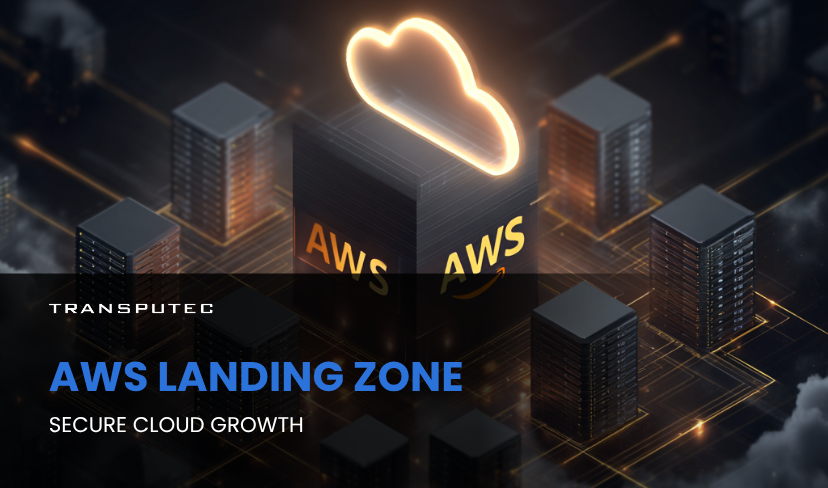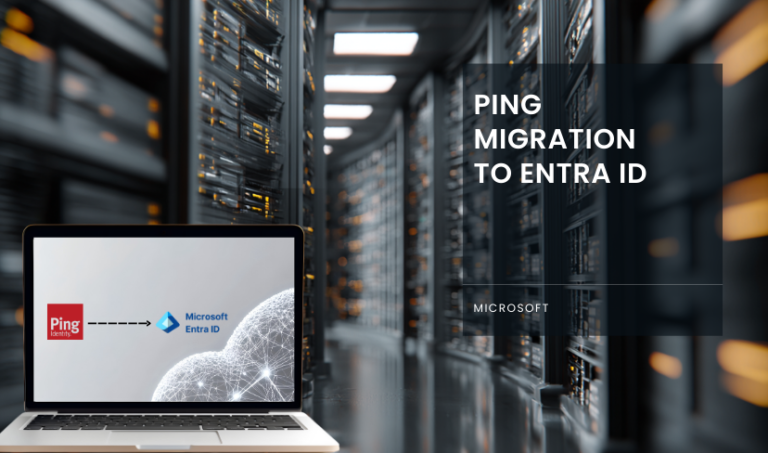Written by KRITIKA SINHA | TRANSPUTEC
Every month your team wrestles with scattered cloud accounts, inconsistent security settings, and endless debugging of permissions. One misconfigured rule, one missing log setting, and you risk exposure, audit failure, or throttled resource limits. That chaos is not inevitable. Enter the concept of AWS Landing Zone — the structural foundation that holds your AWS world together.
In this blog you’ll learn exactly what an AWS Landing Zone is, how it solves real business headaches, how to deploy one (including via AWS Control Tower or custom builds), and why working with an AWS Advanced Partner like Transputec can make the difference between a fragile setup and a resilient, secure cloud foundation.
What Is an AWS Landing Zone?
Put simply, an AWS Landing Zone is a prescriptive, well-architected multi-account AWS environment built to scale securely and reliably.
That environment codifies best practices: account structure, identity and access management, governance guardrails, network architecture, logging, security baselines, and automation.
Why is that needed? Because as your AWS use grows — more teams, more workloads, more compliance demands — ad hoc account setups quickly become liabilities. A landing zone acts like your “cloud base camp,” enabling new workloads to be onboarded into a secure, governed structure with minimal friction.
Why Your Business Needs an AWS Landing Zone?
When you don’t have a proper AWS Landing Zone, you risk:
Security gaps: Missing centralised logging, inconsistent IAM roles, or missing guardrails can expose you to threats.
Audit pain: Without a clear governance boundary, compliance audits become tedious and error-prone.
Operational blowups: One team’s misconfigured VPC or misapplied policy could affect others.
Slow onboarding: Spinning up new AWS accounts or environments often becomes a manual, error-prone chore.
By contrast, a properly built AWS Landing Zone offers:
Guardrails and governance out of the box
AWS Control Tower, often used in landing zones, provides prebuilt controls (both preventive and detective) you can enable to enforce policy across accounts.Automated account provisioning (Account Factory / AVM)
New accounts can be “vended” via templates that enforce baseline settings (network, policies, logging) so you don’t re-invent from scratch.Consistent security baseline and logging
CloudTrail, AWS Config, central log account, GuardDuty, and encrypted storage can all be built into the landing zone, giving you unified visibility.Modular scalability
The landing zone is built to grow. Whether you add 5 accounts or 500, the same guardrails, blueprinting, and governance apply.Faster, safer migrations
When migrating workloads into AWS, the landing zone reduces friction — you already have the framework in place.Cost clarity and separation
By structuring workloads into distinct AWS accounts, you get cleaner billing, limit quotas per account, and isolate cost spikes.
Empirical note: AWS’s own documentation argues that organisations should adopt a multi-account framework because “an account is a unit of security protection” — isolating one workload in its own account can reduce the blast radius of any issue.
Some cost overhead exists: AWS Config rules, GuardDuty, and logging infrastructure might cost in the order of USD ~ 200/month baseline (varies by scale) But in many cases that cost is rationalised by risk reduction, compliance assurance, and operational ease.
Ready to Secure Your Cloud with Confidence?
Connect with us today for our free consultation!
Types of AWS Landing Zone: Control Tower vs Custom
You have two main paths to build your AWS Landing Zone:
1. AWS Control Tower (managed path)
This is AWS’s “opinionated but ready” approach: a service to orchestrate setup of accounts, guardrails, identity, and logging.
Pros:
Faster to deploy a baseline environment
Built-in controls, dashboards, guardrails
Centralised governance and account structure with minimal manual scripting
Trade-offs:
Less flexibility for highly specialised custom needs
Some customisation requires additional tooling (e.g. CfCT, Account Factory for Terraform)
AWS region support constraints
2. Custom Landing Zone
You (or your partner) design and build every component (IAM, network, logging, account factory) yourself atop AWS Organisations.
Pros:
Maximum control and flexibility
Can embed specialised rules, tailor to unusual compliance regimes
Trade-offs:
Requires deep AWS expertise and ongoing maintenance burden
Higher risk of drift, misconfiguration
AWS itself recommends starting with Control Tower and then layering customisations over it if needed.
In highly regulated sectors, the Landing Zone Accelerator on AWS is an advanced offering to deploy a robust foundation with compliance, encryption, and governance baked in via ~35 AWS services.
Anatomy of an AWS Landing Zone
Here’s how typical landing zone structures are organised:
1. Key accounts / organisational units (OUs)
Management / Root account: handles overall organisation, policies
Security account: houses security tools, roles, auditing privileges
Log Archive / Audit account: centralised destination for CloudTrail, Config logs
Shared Services account: directory services, connectivity, common tooling
Workload accounts: separated by environment (dev, test, prod) or business unit
2. Governance & Controls
Service Control Policies (SCPs) that restrict account actions
Preventive and detective controls (via AWS Config, GuardDuty)
Centralised guardrails for compliance
3. Identity & Access
Integration with IAM Identity Center (or external identity providers)
Cross-account roles for auditing / security access
4. Networking & Connectivity
VPC design (shared or per account), network segmentation
Possible shared transit / hub networks
Peering, Direct Connect or VPN setups
5. Logging & Monitoring
CloudTrail across accounts, funnelled to the log archive
AWS Config and rule sets applied consistently
Aggregated dashboards, alerts, anomaly detection
6. Automation & Infrastructure as Code
Use of CloudFormation, Terraform, or similar to define your landing zone
Pipelines (e.g. CodePipeline) to manage changes
Account vending (Account Factory / AVM)
Drift detection and enforcement
7. Security Baseline
Enforce encryption (KMS)
MFA and strong credentials policies
GuardDuty, AWS Security Hub, logging alerts
Root account hardening
This structure ensures you have both isolation (between workloads) and central oversight.
How Transputec Helps You Deploy & Manage an AWS Landing Zone?
At Transputec, our experience with AWS across sectors gives us practical insight into the traps and best paths. Here is how we support businesses:
Discovery & design: We workshop with your teams to define your ideal OU structure, compliance goals, identity setups, and guardrail policies.
Implementation: Whether using AWS Control Tower, CfCT extensions, or building custom landing zones, we codify everything as Infrastructure as Code for repeatability.
Security & compliance: We map out guardrails aligned with your industry (GDPR, SOC 2, ISO, etc.), integrate with your identity provider, and ensure logging and monitoring are baked in.
Migration support: We assist in migrating existing workloads into the landing zone with minimal downtime or disruption—and with safe policy rollouts.
Ongoing management & evolution: AWS changes over time. We monitor drift, apply updates, and help evolve your landing zone to meet new services or rules.
Because Transputec is an AWS Advanced Partner, we have deeper access to AWS resources, best practices, training and early previews—which is a real advantage when building advanced AWS Landing Zone solutions tailored for your business.
Conclusion
We’ve covered what an AWS Landing Zone is, why it’s critical for growing businesses, the major design choices (Control Tower vs custom), the anatomy of a landing zone, and how Transputec can assist in building and managing one. At its heart, an AWS Landing Zone transforms chaos into stability, risk into confidence, and enables secure, scalable cloud adoption.
Contact us to connect with an expert and get started with Transputec.

Ready to see what a true AWS Advanced Tier Partner can do for your business?
Contact us today to schedule a consultation with our experts.
FAQs
1. What makes Transputec a good choice for implementing an AWS Landing Zone?
Transputec holds AWS Advanced Partner status, bringing deeper AWS access, certified experts, and experience across industries. We combine that with custom design, security expertise, and practical migration support to deliver a landing zone that meets your specific needs.
2. How long does it typically take Transputec to deploy an AWS Landing Zone?
That depends on complexity, compliance requirements, and existing cloud footprint. A baseline landing zone might be deployed within days; a fully compliant, customised one could take several weeks. We plan timing up front.
3. Can Transputec integrate the landing zone with my identity provider (e.g. Okta, Azure AD)?
Yes. Transputec has experience linking AWS IAM Identity Center to external identity systems so your users can sign in with existing credentials and access the proper roles across accounts.
4. What if I already have AWS accounts in use—can Transputec bring them under a landing zone?
Yes. We can assess your current accounts, migrate them into the landing zone structure, apply guardrails, and enforce policies, with minimal disruption.
5. Will Transputec help maintain and evolve the AWS Landing Zone over time?
Absolutely. Part of our service is ongoing governance, drift detection, updates, and adaptation as AWS evolves or your business changes. We don’t just build and leave you hanging.




